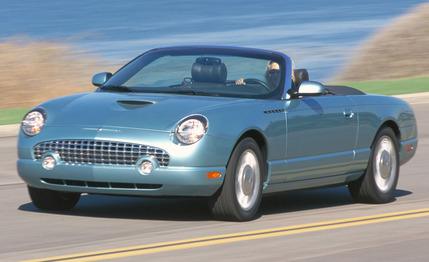
 Short Take Road Test
Short Take Road Test
The auto industry has a vast pharmacopeia of nostrums formulated to cure sales anemia, but our favorite continues to be a massive shot of vitamin HP. It may not cure the actual affliction, but it almost always leaves the patient feeling more vigorous.
With sales lagging some 24 percent behind original forecasts-19,085 in 2002 versus a hoped-for total of 25,000-the Thunderbird does seem to be in need of some sort of showroom stimulant. Ford's approach, in addition to boosting engine output, is to make the car more collectible by limiting production to "four or five" years.
Revived after three years of suspended animation, this Lazarus of T-Birds came to the market in 2001 with an oversupply of hype, an undersupply of chassis, and a power supply that was only adequate.
You might have observed that whatever the resurrected Bird lacked in sports-car-ness it made up in style, and you'd get no argument from us. Ford prefers "relaxed sportiness" as a dynamic descriptor. No argument from us on that one, either. In this sense, the revival Bird is faithful to the 1955-57 original, which the company characterized as a "personal car." Our own assessment, expressed in a T-Bird test in the June 1956 issue of C/D predecessor Sports Cars Illustrated, described the car as "best suited to turnpikes and drag strips."
But we digress. We were discussing horsepower, as in more of it. The new Thunderbird arrived with the same 4.0-liter aluminum V-8 employed to propel the Lincoln LS, a destroked and slightly dumbed down (no variable valve timing, for example) version of Jaguar's 4.0-liter DOHC AJ-V8. It was rated at 252 horsepower and 267 pound-feet of torque compared with 281 horsepower and 287 pound-feet for the Jag mill-all of this to eliminate any possibility of Jag buyers thinking their elegant new cats were propelled by something as plebeian as a mere Ford engine.
The two engines have diverged further in recent revisions. Introduced with the updated S-type last year, the Jag V-8 went from 4.0 (3996cc) to 4.2 liters (4206cc), thanks to a lengthened (by 4.3mm) stroke. The displacement increase, along with other enhancements (an improved variable-valve-timing system and better breathing), bumped output to 294 horsepower and 303 pound-feet of torque. Displacement of the Ford/Lincoln version, meanwhile, is unchanged at 3950cc, but the addition of variable valve timing (intake side only), extensive cylinder-head revisions, and a slight increase in compression (10.8:1 versus 10.6:1) add up to useful power gains: 280 horsepower and 286 pound-feet of torque. And this, in turn, adds up to better in the time-to-speed department: 0 to 60 in 6.5 seconds versus 6.9 seconds for the softtop Bird we tested in July 2001. (With the optional 91-pound hardtop attached, that '02 car hit 60 in 7.0 seconds.) The vitamin-HP-enriched '03 Bird covers the quarter-mile in 15 seconds flat at 95 mph, versus 15.2 at 94 for the '02 version, and hits 100 mph in 16.8 seconds compared with 17.4. These are obviously not night-and-day distinctions, but the car does feel livelier in the cut and thrust of urban traffic.
A couple other noteworthy updates: The '03 Bird has a modestly revised instrument panel, with analog gauges that look more conventional-and hence less wispy in daylight driving-than the previous readouts. And there's also the option ($130) of a Select Shift version of the car's standard five-speed automatic transmission. Like other trannies of this type, it offers the illusion of manual shifting, and to be fair, it will hold the chosen gear right up to the rev limiter (there's no redline on the tach). On the other hand, up- and downshifts are languid, and the only advantage is that it keeps the transmission from excessive hunting during suburban and country driving.
The Thunderbird's modest enhancements don't extend to its rather elastic chassis, and there's still a lot of wind noise coming through the canvas top at freeway speeds. And it hasn't gotten any cheaper. The as-tested price of our 2002 T-Bird came to $39,867 compared with $41,795 for this similarly equipped '03 car. For the same money, you could strap on an Audi TT roadster, a BMW 325Ci convertible, or a Saab 9-3 convertible. To name just a few.
Memo to Ford: Increasing the price is not a nostrum for slow sales.
Still, with or without its '03 vitamin supplement, we have a soft spot for Ford's stylish boulevardier-just as we did in 1956, when we summed up the T-Bird as "an esoteric gospel for the unsaved."
What does that mean? We're not really sure. But it still seems to apply.